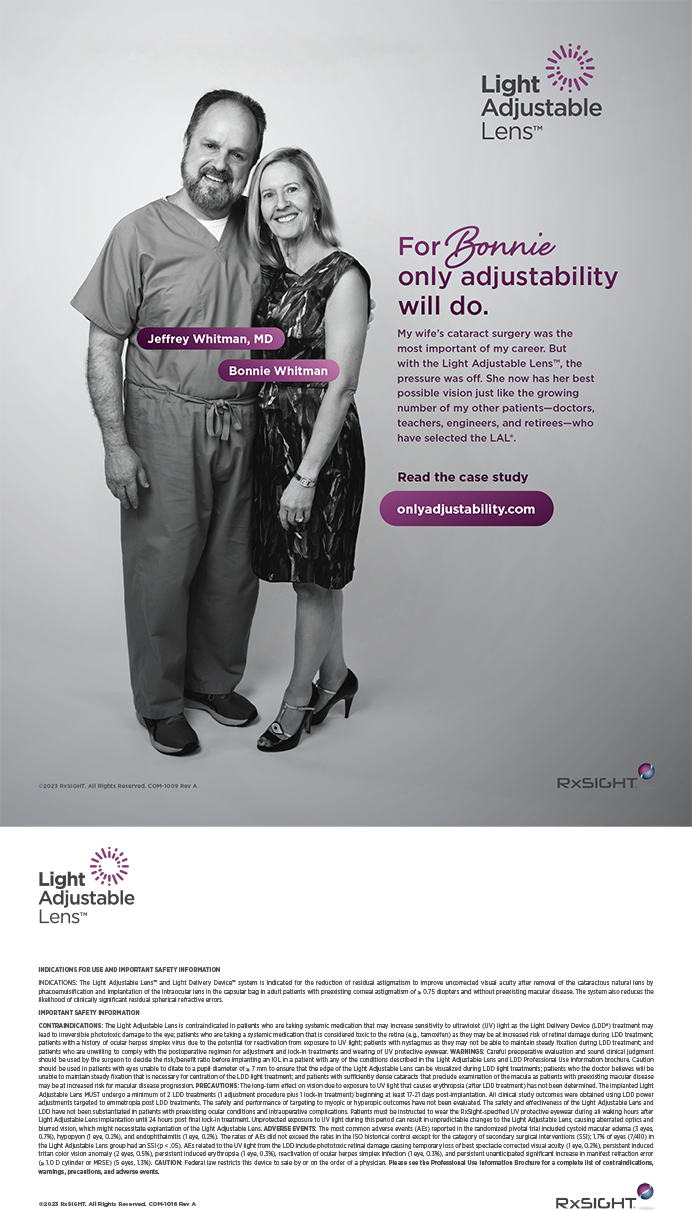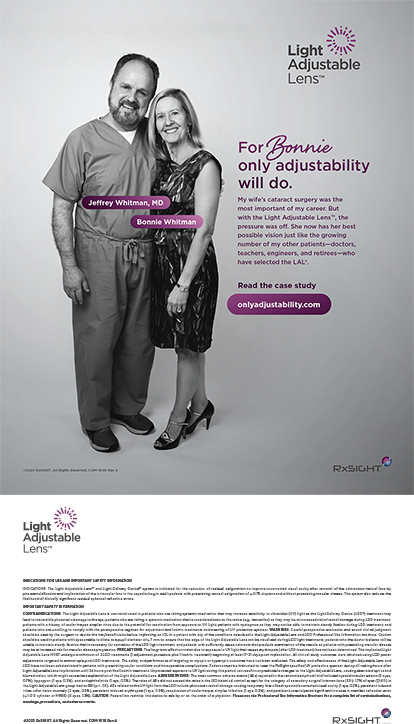The LASEK procedure, which is actually an advanced PRK, takes the same amount of time to perform as PRK or LASIK. It requires fewer instruments, and produces fewer complications. The actual technique takes about 4 to 5 minutes. I use a preoperative antibiotic as well as anesthetic and do a normal prep around the eye. To hold the eyelashes out of the way, I use a superior drape; there is no need to drape inferiorly, because I am not using a microkeratome. One drop of anesthetic is used before the prep, and one after. I mark the epithelium with an RK marker because when I lay the epithelium down later, I want to know where it was to begin with—marks on the cornea are even more important in LASEK than in standard LASIK.
CREATE A SCORE
To make a score in the epithelium, I use an 8-mm trephine that has an 8-mm circle, with the hinge superiorly. The resulting well that holds the alcohol fluid is usually 0.5 mm larger than the trephine, so I use an 8.5-mm well, and then 20% alcohol diluted with either BSS® (Alcon Laboratories, Inc., Fort Worth, TX) or sterile water. Depending on the age of the patient, and the solution I am using, I leave the alcohol solution on between 15 and 30 seconds.
MAKE A BREAK
I use a micro-hoe to cause an epithelial break at 6 o'clock. I envision this as an epithelialrhexis, something similar to a capsulorhexis where we take the break at 6 o'clock and extend it around following the score in the epithelium, using the micro-hoe around the periphery. I use a spatula to push the epithelium up superiorly, and then I clean the surface of the cornea with a dry Weck cell sponge and perform the ablation. In doing the ablation, if you have a laser that has pulses which will hit the epithelium, it is important to cover it with a Weck cell sponge to block the pulses from hitting it.
I irrigate the surface, and using a spatula, replace the epithelium and line up the marks that were previously made on the epithelium. Then I use oxygen running at 2 liters, and I blow on the surface until it shrinks. I irrigate the surface with BSS®, and then place a contact lens on the eye. My contact lens of choice is the Bausch & Lomb SofLens 66® (Bausch & Lomb, Rochester, NY). I use NSAID drops every 2 hours for the first 48 hours.
MEDICATE AS NECESSARY
I usually use a narcotic pain medication as needed, and examine the patients 1 hour after surgery. It is interesting to note that these patients actually see better than LASIK patients within their first hour after surgery which was a surprise to us. Postoperative follow-up is to make sure that the contact lens fits properly for the first 3 to 4 days and that there is no evidence of infection, the lenses fitting too tightly, or corneal edema. Then the contact lens is removed for 3 or 4 days, and I stop the steroids after about a week. I don't use any steroids postoperatively unless the patient needs them.
AN APPROACH FROM ITALY
This LASEK technique was developed by Paolo Vinciguerra, MD, from Milan, Italy, and presented at the recent ESCRS meeting in Amsterdam, the Netherlands. Instead of creating a circular score in the epithelium prior to applying the alcohol, the surgeon makes a 1-mm linear abrasion straight down the center of the cornea. After applying the alcohol, the surgeon undermines the epithelium with a spatula, and opens it like a curtain. The epithelium is opened vertically, protected from the laser, then closed, and a bandage contact lens is applied. The advantage of this technique is that instead of the epithelium having to regrow around a 300º break, it only has to regrow from the periphery over an approximate 20º break. Although it is too early to tell, this approach may well prove a viable alternative.
Herman D. Sloane, MD, FACS, FACES, is the President of Sloane Vision Center, Oak Brook Illinois. Dr. Sloane may be reached at (630) 368-6100; freecap@attglobal.net


